How to Optimize Unity Ad Creatives?
If you're seeking methods to optimize Unity ad creatives, this blog post will assist you in addressing your concerns.
Firstly, you need to understand Unity ads.
Overview of Unity Ads
As a part of the Unity platform, Unity Ads provides developers with a robust tool to integrate advertisements into their applications and games, thus creating new revenue streams. With the rapid growth of mobile devices and the gaming market, Unity Ads has become a crucial bridge connecting developers and users, facilitating a mutually beneficial relationship. Through carefully designed ads, developers can achieve their commercial goals without disrupting user experience, providing a way to interact with players and generate revenue.
Unity Ads occupies a significant position in the field of in-game and in-app advertising. Unity Engine is one of the most popular game development platforms globally, naturally leading to widespread attention and application of Unity Ads. Its advantages lie in its ability to offer highly customized solutions to meet the needs of different developers. Additionally, Unity's advertising technology is continually evolving, providing more possibilities for precise targeting and efficient display.
Why Choose Unity Ads?
- Seamless Integration: Unity Ads seamlessly integrates with the Unity Engine, allowing developers to easily incorporate ads into their projects.
- Diverse Ad Formats: Developers can choose the most suitable ad formats based on the characteristics of their games or applications.
- User-Friendly: Unity Ads prioritize user experience, avoiding disruptions caused by ads.
- Revenue Optimization: Tools and services provided by Unity can help developers optimize ad displays and increase revenue.
- Global Coverage: Unity Ads service covers global markets, providing developers with a broad user base.
Comprehensive Analysis of Unity Ad Types
Banner Ads: Concise and Effective
Banner ads are one of the most common ad formats, usually placed at the top or bottom of the screen, without overly disrupting the user's gaming experience. The advantage of these ads lies in their unobtrusive presence, providing continuous revenue without interrupting the user flow.
Additionally, using customizable banner templates can help create visually appealing ads quickly, ensuring they are consistent with your branding while maintaining a seamless user experience.
Applicable Scenarios:
- Suitable for games that need to minimize user disruption.
- Suitable for applications where users spend extended periods online, such as strategy games or social apps.
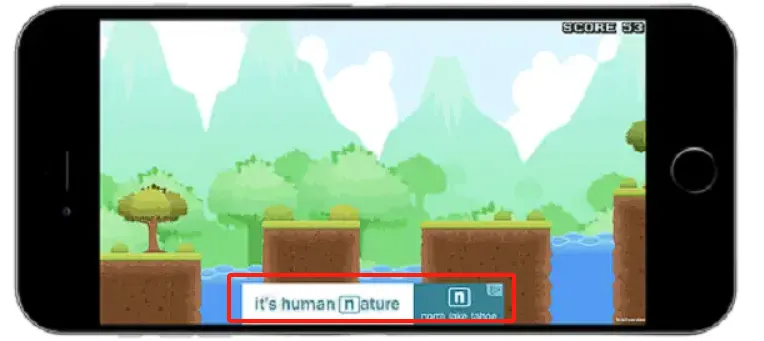
Interstitial Ads: Balancing Experience and Revenue
Interstitial ads, also known as full-screen ads, appear at natural pauses in the game, such as at the end of a level or when a character respawns. They typically occupy the entire screen, providing a richer visual experience.
Applicable Scenarios:
- Suitable for games with brief moments of rest for users, such as puzzles or casual games.
- Suitable for ads that need to display more information or graphics, such as promoting new games.

Rewarded Video Ads: Deep Interaction and User Incentives
Rewarded video ads are incentive-based ads where users can earn in-game rewards, such as virtual currency, extra lives, or additional levels, after watching the ad.
Applicable Scenarios:
- Suitable for games where users are willing to spend time for additional content or advantages.
- Suitable for apps aiming to increase user engagement and in-app purchases.

Playable Ads: Seamless Integration with User Experience
Playable ads allow users to experience a small part of the game while watching the ad. This type of ad provides users with an intuitive gaming experience without requiring them to immediately download the full game.
Applicable Scenarios:
- Suitable for games aiming to showcase complexity or depth.
- Suitable for attracting potential users with specific interests in games.
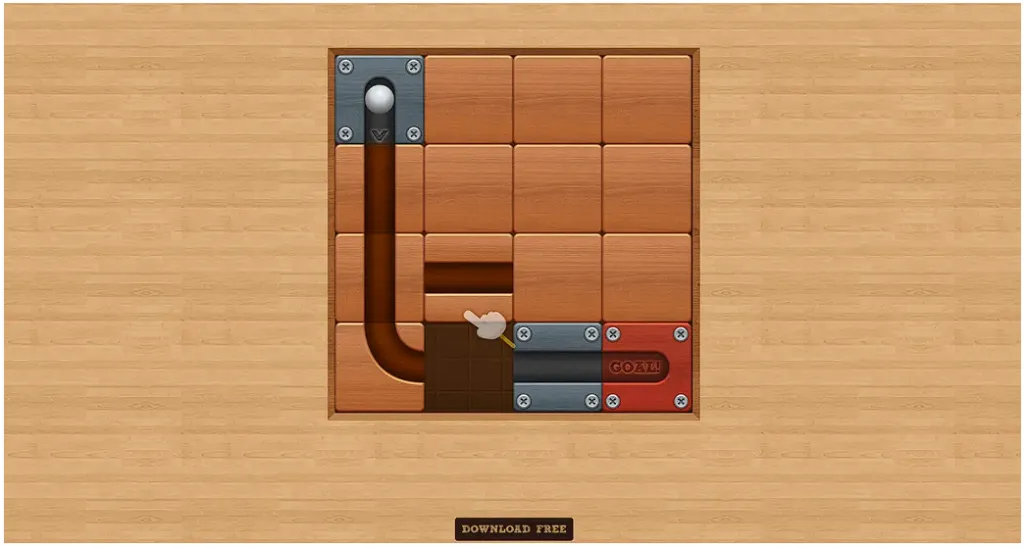
Operation Mechanism of Unity Ads
The operation mechanism of Unity Ads is a complex and sophisticated system that provides developers with a powerful platform to optimize their advertising strategies through precise ad requests, intelligent display logic, and in-depth tracking analysis. By fully utilizing the tools and features provided by Unity, developers can effectively enhance the relevance, attractiveness, and conversion rates of ads, thereby achieving sustainable revenue growth while improving user experience. It allows targeting specific demographics, making it easier for game developers to reach their desired regional audiences.
How to Optimize Unity Ad Creatives-Promotion Strategies
Within the Unity Ads ecosystem, creativity is not only an element that attracts users' attention but also a key factor in improving ad effectiveness and revenue. Here are some practical tips and methods to help developers increase user engagement and ad revenue through creative optimization.
User Insights and Targeting
The first step in creative optimization is to deeply understand the target user group. Through user research, data analysis, and market trends, developers can gain insights into user needs and preferences, thus designing more attractive ad content. Targeting the desired user group ensures that ad creatives match the interests and expectations of users.
If you need to know who your competing products are reaching, BigSpy can help you.
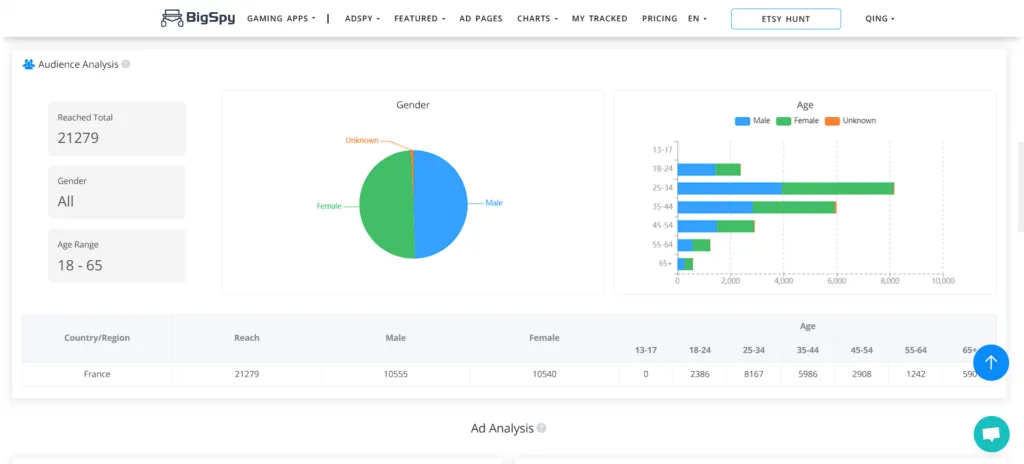
Personalization of Creative Content
Personalization is a crucial strategy for improving ad effectiveness. Developers can customize ad content based on user behavior, preferences, and game progress. For example, for users who frequently play action games, ads related to action may be displayed, while for those who prefer casual games, more relaxing and enjoyable ad content may be shown.
Or you can use BigSpy to get the hottest and most popular creative trends.
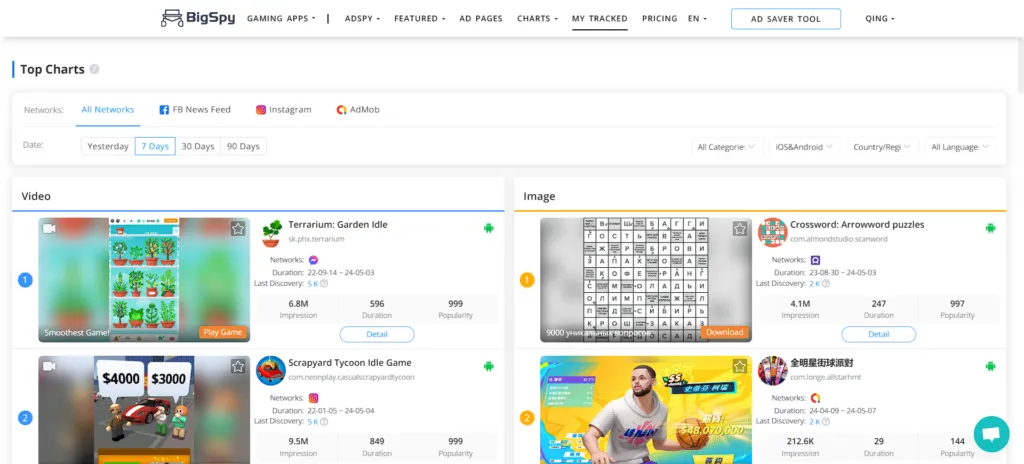
Storytelling and Emotional Connection
Storytelling is a powerful creative technique that can establish an emotional connection with users. By telling a captivating story, ads can evoke users' curiosity and emotional resonance, thereby increasing user engagement and memorability.
Interactivity and Engagement
Interactivity is key to increasing user engagement. Developers can design highly interactive ads, such as gamified playable ads, allowing users to experience the fun of the game while watching the ad. This sense of participation significantly enhances users' interest in ad content and favorability towards the brand.
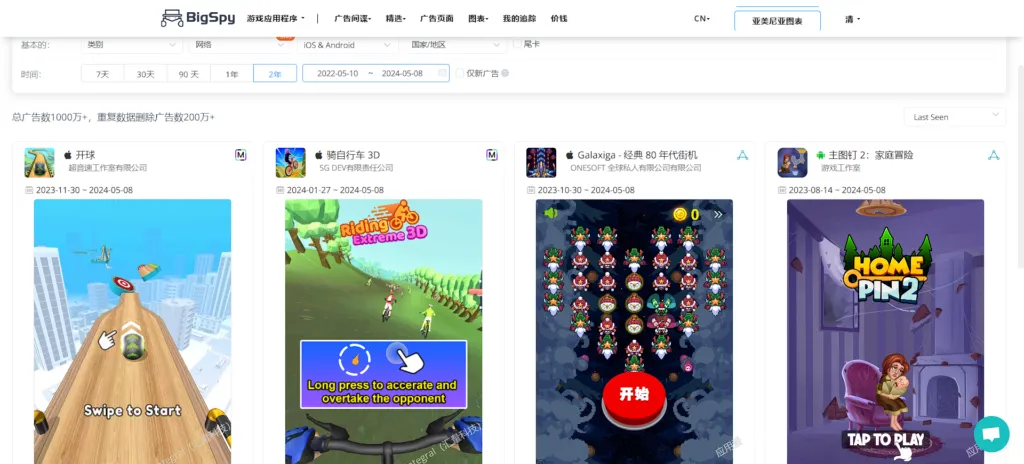
Optimization of Visual and Auditory Elements
Visual and auditory elements are crucial for the attractiveness of ads. Developers should focus on visual design, using high-quality images and animations, as well as appropriate music and sound effects, to enhance the attractiveness and memorability of ads.
A/B Testing and Continuous Optimization:
A/B testing is an effective optimization method. By comparing the performance of different ad creatives, developers can identify the most effective ad versions. Through continuous testing and optimization, developers can continuously improve ad creatives to achieve the best advertising results.
Utilizing Unity's Ad Tools and Services:
Unity provides a range of ad tools and services, such as Unity Analytics and Unity Ad Manager, to help developers optimize their advertising strategies. By utilizing these tools, developers can better understand ad performance and develop more targeted optimization strategies.
Through the above strategies, developers can effectively optimize Unity ad creatives, enhancing ad effectiveness and revenue. Creative optimization is a continuous process that requires developers to continually learn, experiment, and optimize. By deeply understanding users, personalizing creative content, telling compelling stories, increasing interactivity, optimizing visual and auditory elements, conducting A/B testing, and making full use of Unity's ad tools and services, developers can design more attractive and impactful ads, thus standing out in the fiercely competitive market.
FAQs
Are Unity Ads better than Google Ads?
- Game and App Type: Unity Ads are designed specifically for games and apps developed using the Unity engine, offering tightly integrated advertising solutions for game development environments. If your game is developed using the Unity engine, Unity Ads may be more convenient to integrate and optimize.
- Ad Formats: Unity provides various ad formats such as rewarded video ads and playable ads, which may be more suitable for gamified ad experiences. AdMob also offers video ads and banner ads, suitable for a wider range of application scenarios.
- Revenue Optimization: Both platforms provide revenue optimization tools, but the actual revenue performance is influenced by factors such as ad fill rate, eCPM (cost per thousand impressions), and user geographic location.
Should I use AdMob or Unity Ads?
- Integration Convenience: If your game or app is developed using Unity, Unity Ads may be easier to integrate and maintain.
- Audience Targeting: Consider your target user group. If they primarily download apps through Google Play, AdMob may provide more precise targeting and higher fill rates.
- Ad Type Requirements: Choose based on the types of ads you wish to display in your app. For example, if you need rewarded video ads, Unity Ads may be the better choice.
- Revenue Comparison: Compare the revenue performance of both platforms through small-scale testing and make decisions based on actual performance.
- Technical Support and Community: Consider the technical support and activity of the developer community provided by both platforms, choosing the platform that provides more assistance and resources.













